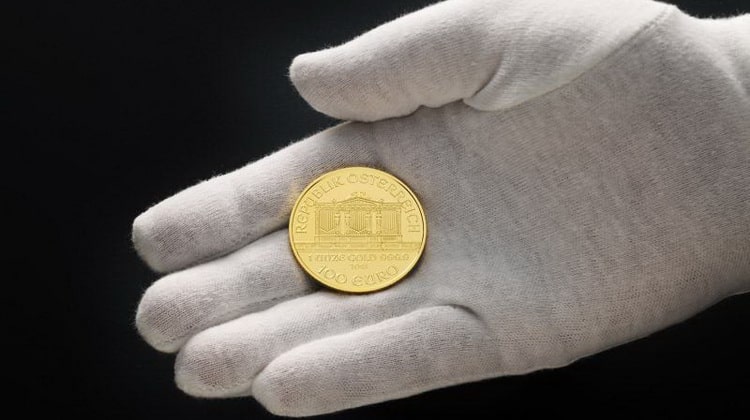
Commemorative gold coins of Austria have been minted since 1908 when after the monetary reform of 1892, coronas were introduced into circulation. Nowadays, the issue of such coins has become regular and serial. All Austrian gold coins in our catalog. Since the introduction of the euro, the Austrian mint annually issues 50 and 100 euro coins of various series, which are dedicated to some historical events of Austria, famous people, monuments of architecture and art, as well as everything that reflects the heritage of the country and its modern life. Commemorative coins can be a legal tender, but only in Austria.
Ancient commemorative gold coins
Commemorative gold coronas of 1908
Gold coins of 10, 20 and 100 corona denominations were issued in 1908 as a separate circulation and in a new design. They were dedicated to the 60-year rule of Franz Joseph I, the only king of Austria who had ruled the country for so long.
- 10 coronas
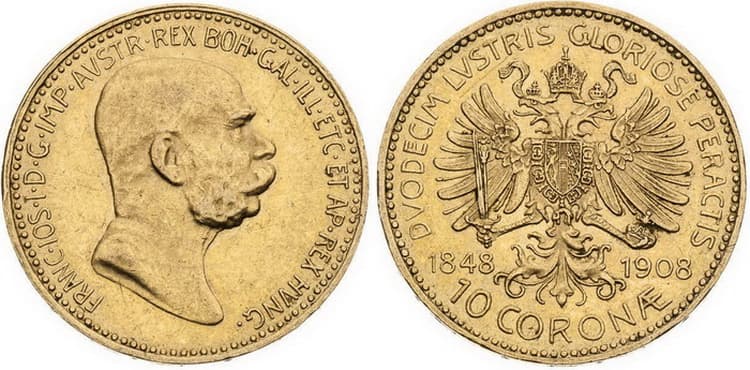
- 20 coronas
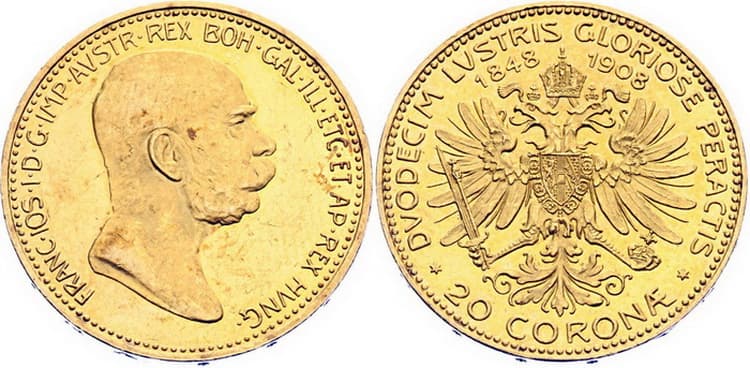
- 100 coronas
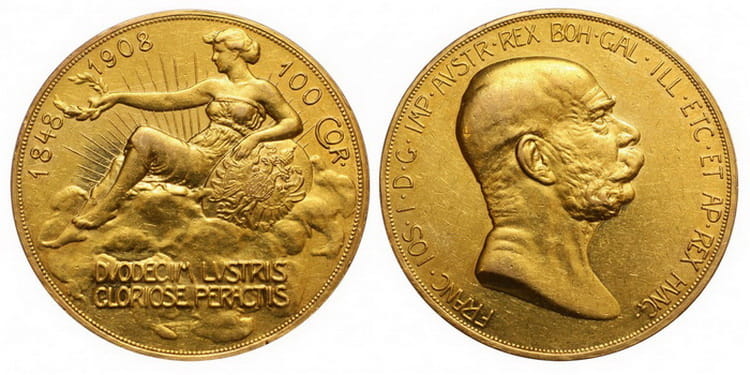
Commemorative gold shillings of 1935
This gold coin depicts the Great Mother of Austria Madonna of Mariazell, who was considered the patroness of the country.
- 100 shillings
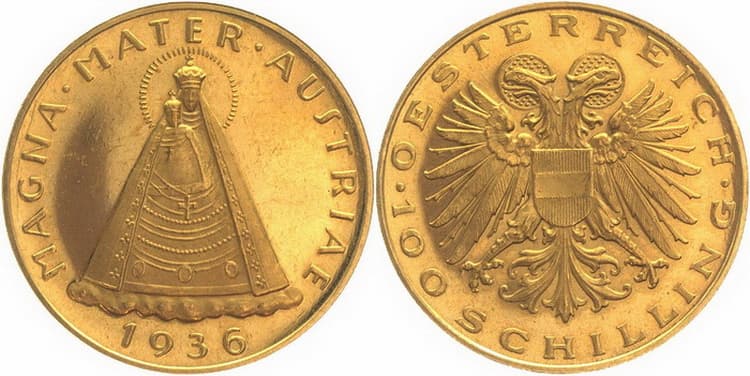
2000 Schilling 2001 Austrian gold coin in our catalog.
Series of commemorative gold euros
50 euro denomination of .986 gold
50 Euro 2009 Austrian gold coin in our catalog.
2,000 years of Christianity
- The Catholic Order of St. Benedict – March 13, 2002. This coin was created in memory of St. Benedict, who is considered the patron of monasticism and whole Western Europe. In 6th century, he developed the canons for the monk’s life, which are relevant to this day.
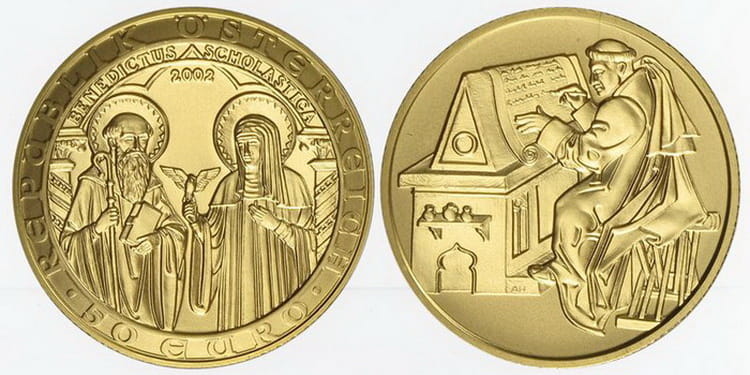
- Christian Mercy –March 12, 2003. This coin demonstrates a fragment of the famous parable about Good Samaritan from the New Testament on the one side, and an example of Christian virtue on the other.
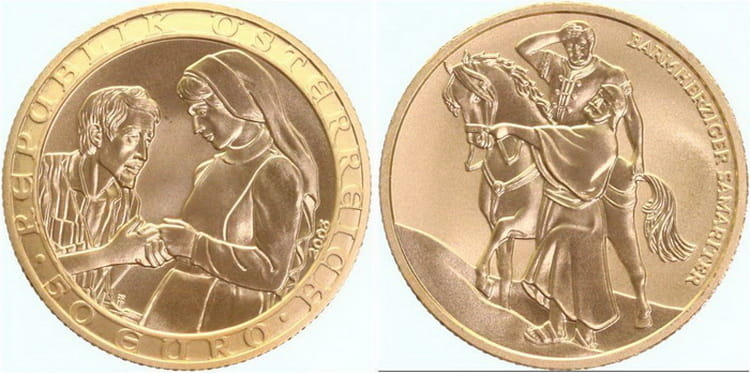
Great composers
- Joseph Haydn –March 20, 2004. This coin was the first in the series “Great Composers”. Joseph Haydn was the inspiration for Beethoven and Mozart and is still considered one of the most innovative composers of his time.

- Ludwig van Beethoven –February 16, 2005. This coin is dedicated to Ludwig van Beethoven and his famous Symphony No.3, which received the title “Heroic” in 1806. The composer dedicated it to Prince Joseph Franz Maximillian von Lobkowitz, whose palace is depicted on the reverse of the coin.
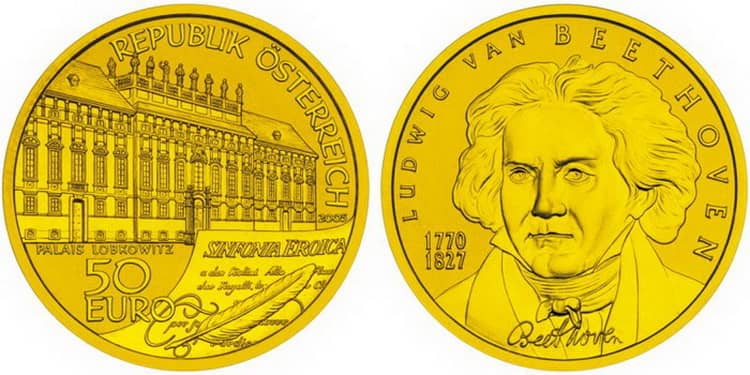
- Wolfgang Amadeus Mozart –February 1, 2006. This composer is one of the personifications of Austria; therefore his portrait along with a portrait of his father (also a well-known composer) is placed on the obverse of a gold coin. The reverse depicts a house in Vienna in which he was born and raised.
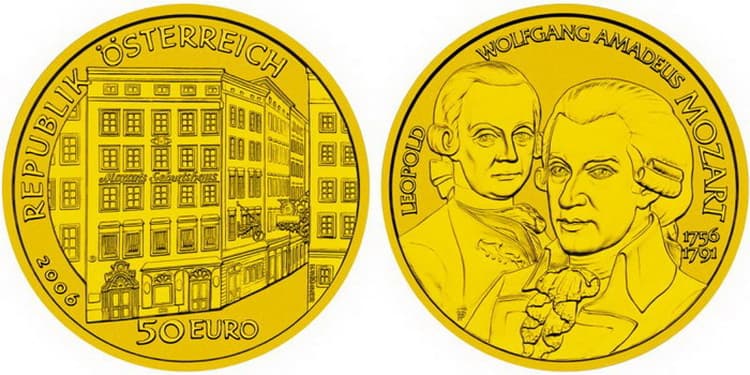
Famous doctors of Austria
- Gerard Van Swieten – January 31, 2007. This coin was the first in the series “Famous Doctors of Austria” and was dedicated to the founder of the first Viennese medical school Gerard van Swieten.
- Ignaz Philipp Semmelweis – January 30, 2008. This coin is dedicated to the famous Viennese doctorIgnaz Philip Semmelweis, who worked all his life in the maternity hospital.
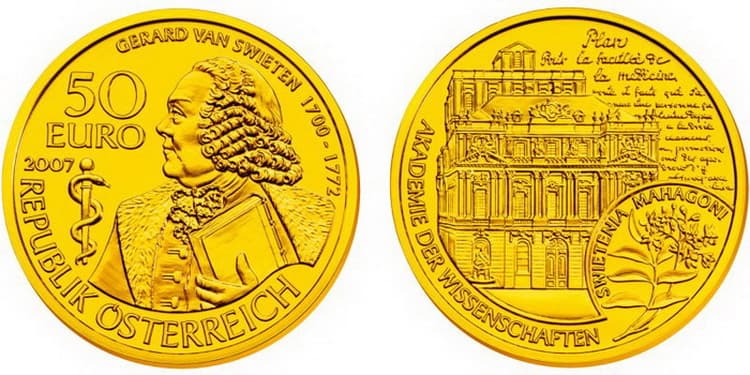

- Theodore Billroth – February 11, 2009. Theodore Billroth is famous for his innovative techniques in surgery. He laid the foundation for the antiseptics use in surgeries. He found his own clinic, in which he worked during all his life.
- Clemens von Pirquet – May 26, 2010. Clemens von Pirquet is known for his theory of allergy and the introduction of such a notion in medicine. He invented a tool for detecting tuberculosis infection.
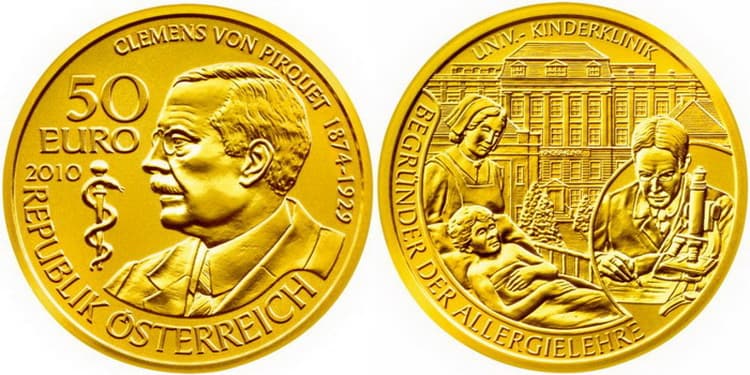
Klimt and his women
The Austrian mint dedicated this coin series to the 150th anniversary of the famous Austrian artist Gustav Klimt, capturing his paintings on each of the coins.
- Portrait of Adele Bloch-Bauer – January 25, 2012.
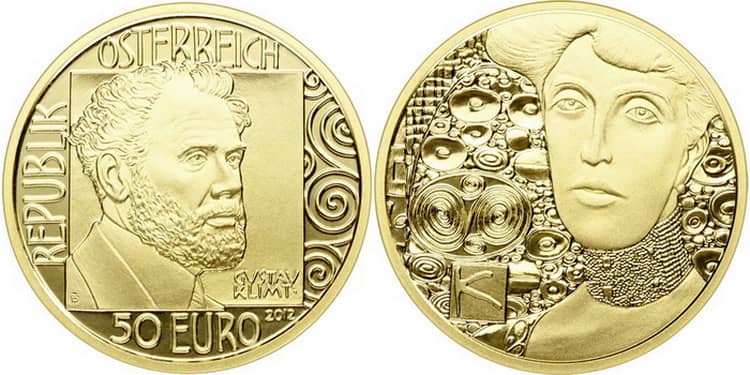
- The waiting – February 27, 2013.
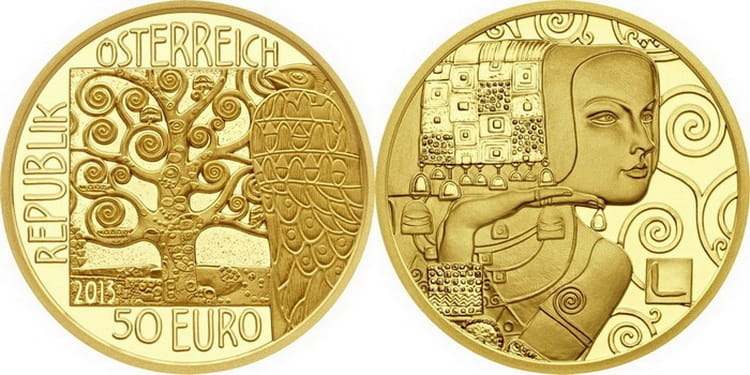
100 euro denomination of .986 gold
Art treasures of Austria
This series demonstrates the cultural heritage of Austria of different periods, marking the most outstanding personalities on every coin, such as Raphael Donner and Gustav Klimt.
- Sculpture – November 13, 2002.
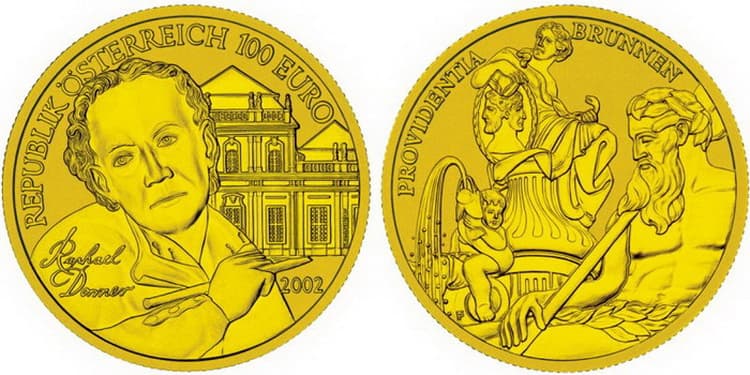
- Painting – November 5, 2003.

Viennese Art Nouveau
This series of coins is dedicated to the most famous and iconic architectural buildings of Vienna, which represent the city. 200 Schilling 2001 Austrian gold coin in our catalog.
- Vienna Secession –November 10, 2004.
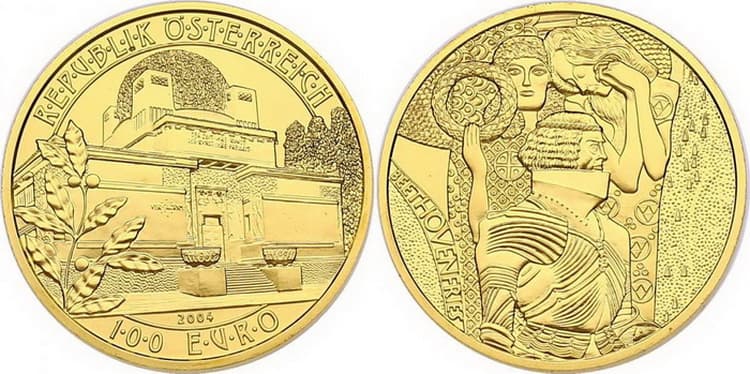
- Steinhof Cathedral – November 9, 2005.

- The Vienna River Gate – November 8, 2006.
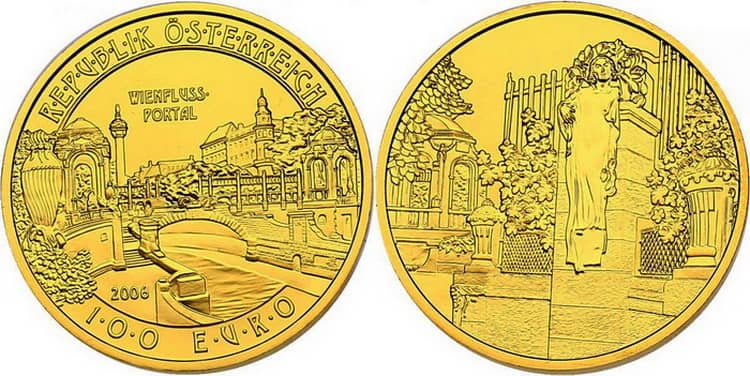
- Vienna Architecture –November 7, 2007.

The Crowns of the House of Habsburg
This series of coins shows not only the famous crowns of Austria and Austria-Hungary but several eras of the reign of kings from Otto I to Franz Joseph I. All 100 Euro Austrian gold coins in our catalog.
- Imperial Crown of the Holy Roman Empire – November 5, 2008.

- Crown of the Archduke of Austria – November 4, 2009.

- Hungarian Crown of St. Stephen – November 10, 2010.
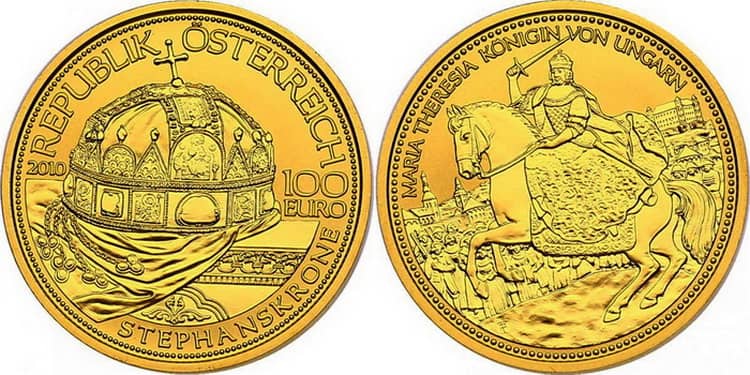
- The Czech Crown of St. Wenceslas – November 9, 2011.
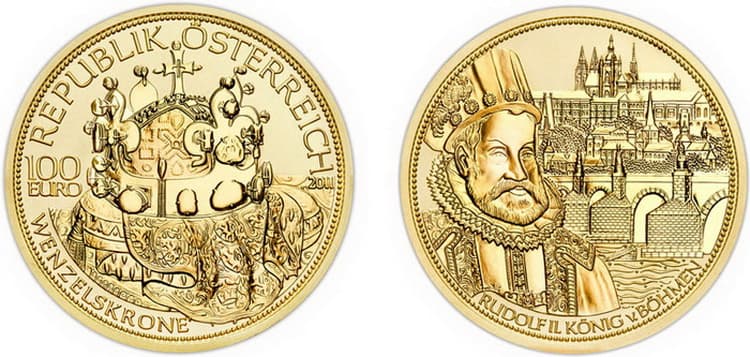
- Crown of the Austrian Empire –November 14, 2012.
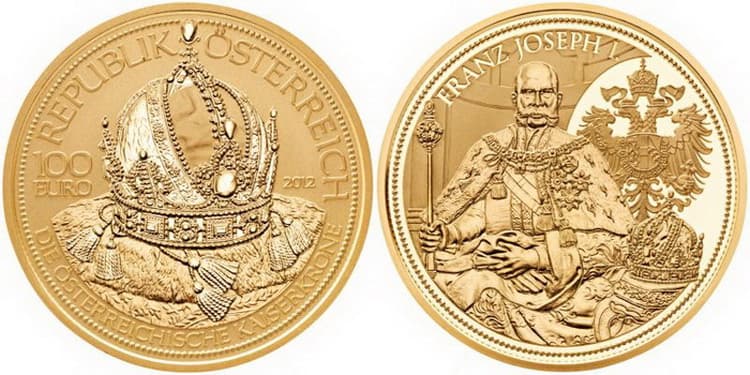
Our Wildlife
This is one of the newest and most demanded series, the copies of which are sold out in a matter of hours immediately after their minting. It is the brightest and most interesting in design and represents the richness of the wildlife of Austria.
- The Red deer – October 30, 2013.
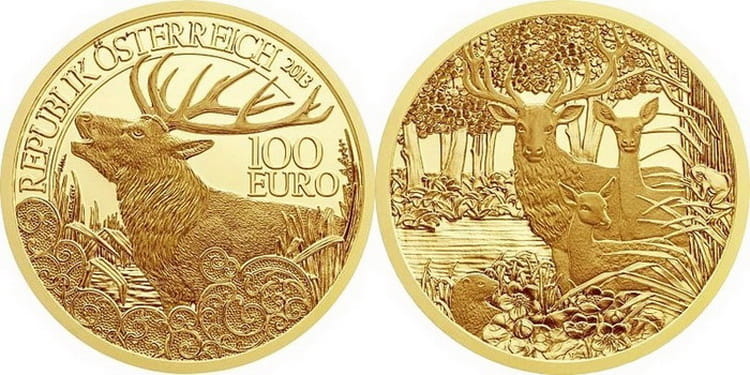
- The Wild Boar – 2014
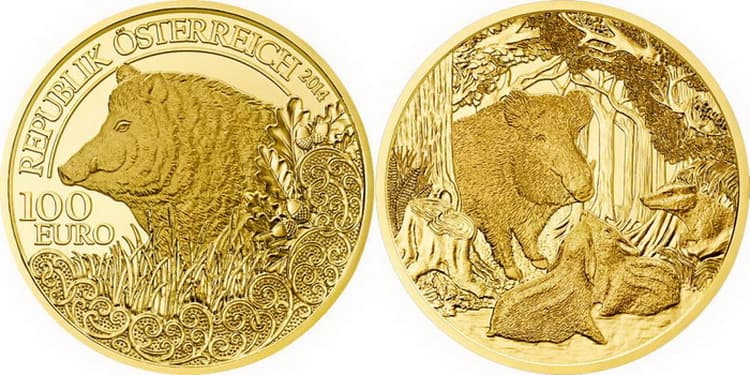
The design
The Austrian mint issues commemorative gold coins with circulations ranging from 50,000 to 500,000 copies. You can buy such coins either wholesale or retail. If you decide to buy one coin for your collection, it will have a beautiful individual package, and when you buy lots, coins are packed in plastic tubes.
As for the coin design, it is done by design artists who often work in pairs. The Austrian mint has a whole team of such specialists on its staff:
- Thomas Pesendorfer;
- Helmut Andecklinger;
- Herbert Weiner;
- Andreas Zanaszka.
It is worth noting that Thomas Pesendorfer was appointed as a chief engraver of the Austrian Mint after his individual work on the “Philharmonic” (gold series).

The cost of commemorative coins

Commemorative gold coins are a subject of interest for numismatists and collectors. The price for each copy depends on many factors. When talking about old commemorative coins, it is essential to understand that they were released in a small circulation and are quite rare today. The price is also affected by the quality of gold (it may have additional admixtures), the condition of the coin and the demand on the numismatic exchanges. So, for example, the cost of 10 gold Austro-Hungarian coronas of 1908 can range from 100 to 250 euros, and 20 and 100 corona denominations – from 3,000 to 40,000 euros. Considering the commemorative gold coins of the last decades, which are minted from gold with a fineness of 986, it is necessary to take into account not only the condition of the coin but also the price of an ounce of gold on the world market.
Interesting facts
- The design of the first commemorative gold euros was created by the professor of the Vienna University of Applied Arts Joseph Kaiser.
- Austria was among the first eleven countries to introduce euro into circulation in 2002.
- Each country of the European Union mints gold and silver commemorative coins on the themes established by their mint and has a unique design.
- In 2010, the Austrian Mint stopped minting the series of gold coins called “Famous Doctors of Austria”, but on January 26, 2011, a separate extra-series of a commemorative coin “200 years of Universal museum Joanneum in Graz” was issued.
Comments
No commens yet.